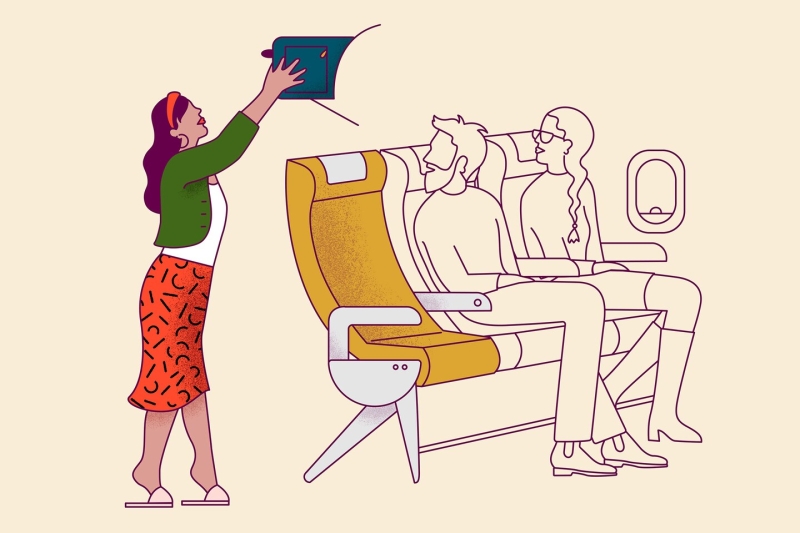Welcome to our series on the unofficial rules for every seat on a plane, where we break down the responsibilities that come with each to promote common courtesy in the skies. This installation focuses on the aisle seat. We’ve also examined the middle and window.
If seats on a plane were children in a family, the aisle seat would be the oldest kid. The aisle seat is the CEO, the team captain, the commander of the ship. Your placement means you’re calling shots. This is a seat for the pragmatic traveler, the one who’s focused on getting in and getting out as efficiently as possible. The aisle seat isn’t staring out the window, dreaming; the aisle seat had the foresight to pick early and avoid the middle.
The aisle seat also comes with a sense of freedom. You want to get up 15 times during the flight whether you need to use the lavatory? Stand whenever you please. You’re not disrupting anyone. (Unless you’re one of the abominable souls who grabs the headrest in front of you with your full body weight every time you get out of your chair. Then you are absolutely disrupting someone. Please, stop doing this. We’re all begging you.)
When you’re seated, you get to test your luck chasing that sweet, sweet feeling of relief when you stretch your leg out into the aisle — if only for a moment. Any longer will run the risk of getting your limb bashed by the service cart. But what a thrill.
Watch your knees and follow the rest of theses rules for taking the aisle seat.
With the closest and easiest access to the aisle, you’re in the prime position to help your fellow man (should you be willing and able). When you see a parent clearly struggling to wrangle kids and lift a bag into the overhead compartment, or an elderly passenger in the same position, do your part and ask whether you can help. You’re packed in an aluminum tube with a bunch of stressed-out travelers — doing something nice goes a long way here. Although no one is going to force you to be kind, consider it an investment in good travel karma for your future adventures.
You are the only obstacle separating your row neighbors and the aisle. That means you’ll be letting them in and out during the flight. You knew this when you reserved your aisle seat, so be a good sport about aisle-access requests. You may be capable of sitting for an entire flight, but others might not be as lucky. Give them a break and keep your feelings to yourself (i.e., no eye-rolling, heavy sighs or the like).
Thanks to your positioning, you’re stuck in between passengers and the flight attendants. By default, attendants may enlist your help to do their bidding. They may need a hand passing things over to your neighbors, waking them up from deep slumbers or waving them out of their headphone-created seclusion. Those who would like as few disruptions as possible during their experience should book the window seat instead.
Time for a multiple-choice quiz. Your plane lands, taxis to the gate, and the “Fasten seat belt” sign dings off. Is it time to (a) stand up immediately and move into the aisle, or (b) stay seated until the row before you leaves, and follow them? You are correct if you answered with either option, because at the end of the day, you get to set the pace of your deplaning.
The completely correct guide to getting off a plane
You can’t control how the other passengers exit, but you can choose to rush or relax yourself. Should a neighbor in your row ask nicely for you to move for them, feel free to oblige their request. If they’re pressuring you non-verbally by hovering over your chair, do not entertain any guilt: That passenger should have booked an aisle seat if they feel so strongly about when to deplane.
However, just because you have the control here doesn’t mean you should abuse it. Unless you have a good reason to wait longer, you should be exiting into the aisle no later than the row in front of you.
We’ve already established that you’re the boss of the row. That’s particularly true if things should go wrong onboard. In the unlikely case of an emergency, the aisle seat needs to be ready to jump up and get going. This is not the seat for panicking or freezing under pressure. It’s your duty to keep it together and stay calm, following flight staff instructions on how to proceed. Lead your row with order and grace.
Read more:
The completely correct guide to who you should drive to the airport
Follow By The Way on Instagram for city highlights, travel tips and more
How to survive 12 hours in an airport

